Forces: Land ~ Air ~ Sea ~ Home
A MILITARY TRIBUTE WEBZINE . . . AS YOU WERE . . .
www.hillmanweb.com/flash
Compiled by Bill Hillman
FLASH. . . Editor and Webmaster: Bill Hillman: hillmans@wcgwave.ca
www.hillmanweb.com/rcaf/mag
JUNE 2003
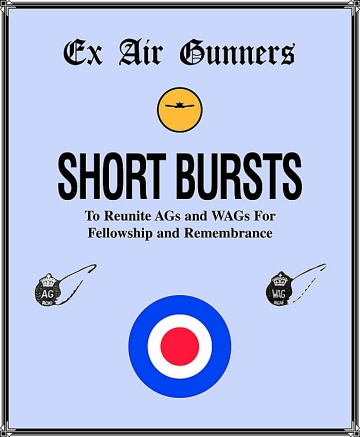
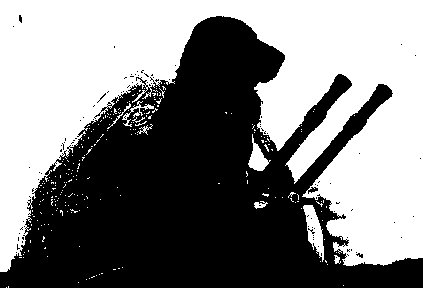
THE VERY FIRST AWACS
By Ross H. Hamilton
It is probably a truism that most military airmen are aware that the present-day AWACS (Airborne Warning and Control Systems) was developed and made known by the Americans long after WWII ended. What they may not know is that the very first AWACS was in fact, initially a development of the British Royal Radar Establishment (RRE), during the latter part of 1944. It is a fact that the aircraft used in the development stages was an anti-surface vessel (ASV) radar equipped Wellington “Wimpy” bomber from 407 “Demon” Squadron, Royal Canadian Air Force. At the time the Squadron was based a Chivenor, North Devon, in England, where its crews carried out anti U-boat patrols over the bay of Biscay, the Atlantic Ocean, and UK sea approaches.
The AWACS was born out of necessity in order to combat the launching of V-1 flying bombs against London. When the launching flights in France were overrun by the Allied armies in the autumn of 1944, the Luftwaffe reverted to its earlier experiments with the art of air-launching certain types of missiles.
Carried under one wing of a Heinkel (He-111), V-1 flying bombs were transported across the North Sea at night, during the worst flying conditions that could be selected. Keeping about 100 feet of altitude, and then launching about 100 miles from London. The Heinkels low altitude kept them below the RAF radar coverage during the approach stage. The Heinkel had to climb to 1,500 feet for the launch, and gain airspeed to 150 mph so that the flying bomb wouldn’t stall when released.
Needless to say, as soon as it got rid of its load, the Heinkel lost no time in turning and diving back to the security of sea level. All this provided a detection period of only some seven minutes for the British radar screens along the Eastern approaches to scramble a night fighter or alert a patrolling one to intercept. Thus all too many flying bombs were getting through to London.
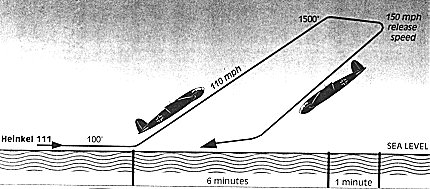
Air Ministry quickly requested the loan of a Mk-X1V Leigh Light equipped Wellington from Coastal Command. Being one of the more highly experienced squadrons of Coastal Command at the time, the signal was passed to 407 Squadron’s Commander, who in turn detached the crew of F/l “Mac” McLean, to RAF Station Ford in Sussex, to subsequently carry out the development and operational flight of what was to become the first AWACS.
All this was carried out in an atmosphere of complete secrecy, and it is doubtful that even our 407 Commanding officer knew what all this was about when he tapped F/L McLean’s crew for the job and cut and cut the detachment orders. Certainly the crew knew nothing about the mission itself for a couple of weeks after arriving at Ford.
My log book shows a transit flight Chivenor to Ford – 21 Nov. 1944, with the Norman complement of aircrew on board – two pilots, a navigator, and three wireless air-gunners, along with a ground crew fitter and mechanic., plus a few spare parts. Our curiosity was only heightened when we landed at Ford for the first time, and our lone Wimpy on the field looked somewhat out of place among the diverse rows of Beaufighters, Mosquitos, Black Widows, et al. These were mostly FIU (Fighter Intrusion Units), day ranger squadrons. Some Lysanders, Hudsons occupied a remote out-of-bounds area at the far side of the airfield, reportedly for use in covert operations, such as dropping agents behind enemy lines, etc. as handled by the “Intrepid” lot.
After a short period of intense training, mainly homing in on fast flying Beaufighters, at very low altitude, at night and in daylight over the channel, we began operations from Manston to Coltishall as quickly as possible due to the V1 threat to London. The two boffins from RRE flew every trip with us, training and ops.

Wellington fitted out with ASV (Air to Surface Vessel radar) regalia.
Ross supplied the caption.
As the Heinkels would normally pick only the foulest nights to go out, it was necessary for the WACS Wimpy and its escort to follow suit. It was very dicey trying to maintain 100 feet altitude in a Wellington over water at night without special instrumentation. (The regular altimeter was useless in this situation.). However, one of the trusty boffins soon came up with a solution – a “radio altimeter.” This consisted of a white light bulb on the plot’s instrument panel which would illuminate at a height of 100 feet. Unfortunately the aircraft could be lower than this, and a lot of attention was needed on the controls to keep the little light blinking on and off – but never on fully for any length of time. Very rudimentary by today’s standards, but it worked.
We also had a quick flight to the maintenance unit at St. Davids to have dual controls installed on the Wimpy. Flying at 100 feet for sustained periods, particularly at night and in awful weather conditions, placed a severe strain on the Skipper, so the flying chore was shared. There was also the factor that if an engine even hiccupped we could be in the drink and one pilot alone would be hard pressed to cope with the immediate response requirements. This was particularly so with an aircraft which hadn’t exactly been designed for this specialized work and was still some 2000 pounds overweight – even without the depth charges on board.
Our nocturnal patrols in the “control” aircraft were usually carried out along a given line up and down the Dutch coast from whence the Heinkels came up. We were normally accompanied by a Mosquito or a Beaufighter, or a combination of both – one to get the Heinkel and the other the V-1 if it had already been launched. Three deadly escorts tailed long a mile or so behind the Wimpy. AWACS and away from the slipstream, the Mossie with its undercart down, plus a bit of flap, so s not to overtake the plodding Wimpy and still stay above stalling speed, including an orbit or two from time to time. The Beaufigher had a much lower stalling speed than the Mossie but his problems of staying airborne were much the same. Both remained very alert waiting for the radio call from the Wimpy when a contact turned up on our long range ASV radar.
At this point there was an immediate transmission to escort one and he was given course to steer that would put him on the tail of the bogey. Now with blips of both the hunted and the hunter on the screen it was a matter of providing continuous and accurate vectors to the fighter as he closed on the target. As soon as he was in the range scope of his AI night fighting radar (about three miles) and now at 1,500 feet, he would announce, “Tally-Ho” and begin stalking for the kill and positive ID.
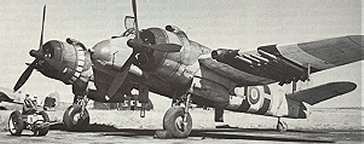
Beaufighter
The system worked well, and plans were soon in the works to form a full AWACS Squadron of ASV equipped Wellingtons with 407 crew as the nucleus. The boffins were also hoping to supersede the Wellingtons with Liberators eventually, the idea being that, with almost double the endurance, continuous patrols could be enacted round the clock, with the escort fighters replacing each other on the patrol line from various bases on the East Coast of the UK.
However, the Canadian army in Holland had other ideas, and soon overrun most of the airfields from which the Heinkel-111s were operating with their deadly V-1 flying bomb cargoes, and effectively put a stoop to their capers. Our Ops with the AWACS became redundant in early 1945, and our crew returned to 407 Squadron to resume regular operational duties. Few of our colleagues at Chivenor knew where we had been for the past several months, and even less about what we had been doing. It was an experience never to be forgotten
The flying bomb assault on London was over, and hopefully, the quick development of the rudimentary (by today’s standards) AWACS resulted in the preservation of at least a few people’s lives in battered London.
But, that same early, nondescript AWACS had proved to be a lusty baby which was later to grow up into a powerful detection weapon. Just for once we Canadians should put aside our modesty and in-born reluctance to brag, and proudly trumpet the honour of providing the very FIRST EVER AWACS, fully crewed by Canadians from 407 “Demon” Squadron, Royal Canadian Air Force.
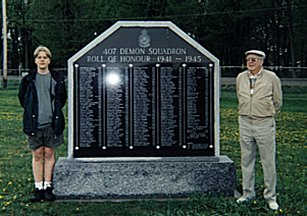
RCAF Museum, Trenton, Ont. Air Force Base.
Grandson Kenny, and Ross Hamilton,
beside the 407 Squadron Memorial dedicated in 1996.
A Don Macfie WWII Anecdote
I really jumped around putting kit away and getting all ready to leave and then down to pay accounts and draw my pay. The pay Sgt. Says, “ on D.R.O.s it says your pay parade is late this afternoon and that’s when you get your pay.” I tried to coax that Sgt. to pay me now, I even got a bit verbal but to no avail. So I went and told Russell I couldn’t go with him.. He said, “Oh well, I have 16 extra as it is.”
When I went to get my pay at 3 P.M. I heard that Russell had crashed into the high hill at Belfast and a lot were dead and burned. Among them was the Station Engineering officer who was a W/C.
In the mess that night I was propping up the bar in some sort of grief when the Account Sgt. Walks over to me and says, “Well this must be the first time Pay Accounts can be credited with saving a life, eh.”
Another 407 Sqdn. Story
This was taken from Short Bursts Newsletter Issue #46 June 1994.
(Eric lives in Toronto and, while we were printing and mailing the Short Bursts he was a faithful contributor to our Newsletter. Eric was awarded the Malta George Cross, and experienced a number of close-calls during his WWII career. This is his LAST PRANG.)
May 1/45: 407 Sqdrn. Detaches several anti-submarine Leighlight Wellingtons from Chinenor (Devon) to Langham (Norfolk) to hunt midget two man German subs prowling the channel and Dutch coast. Our Co-pilot, having been temporarily grounded for medical reasons, and RAF pilot, Sgt. Art Morrison, was drafted to fill in. A seven hour May 3rd. night sub hunt went without incident. During a May 4th. Night op we saw big fires in Holland as Germans blew up supply dumps. Beaufighters from Langham savaged enemy troops trying desperately to escape across Skagerak in anything that floated. What WE didn’t know was that High-ranking Allied and German officers were discussing surrender terms.
Returning to Langham at daylight we landed smoothly. But the Wimpy’s speed strangely did not decrease. Then brakes started screeching and smoking. A weird rumbling signalled we had run out of runway, but were still rolling quite fast on grass! One WAG, Ed. Facey, had been standing in the astrodome. He hurriedly scrambled down to sit with his back in “crash position” against the main spar, and gestured wildly at me to do the same.
Suddenly the brand new Wellington flopped on its belly with a tremendous, rendering crash plus the ear-splitting shattering of both props and nose perspex. The kite slewed wildly, dug up turf and stopped. Hastily unlatching the astrodome, Ed and I rapidly exited. The strong stench of 100 octane fuel spurred us to run, followed by the rest of the other crew members.
No body was hurt but all were shaken and puzzled. Most of all our F/L skipper who shall remain nameless). The Wellington, now an obvious write-off, had halted just short of a tall hedge. Beyond it ws a neat farm house with frightened occupants in the doorway. Had our stand-in Co-pilot not yanked up the undercart, we likely would have demolished the farmhouse considering the Wimpy had a load of depth charges. From a safe distance we lit cigarettes with shaky hands, except our Skipper, a careful very conscientious pilot who didn’t smoke, drink, or swear. Pale and tense, he paced up and down until the crash truck and blood-wagon raced down the runway.
Our pilot’s face got red as he started chastising the
crash crew’s F/Sgt. “We could have been trapped in a flaming aircraft with
depth charges. Where the devil were you guys?”
Raising an eyebrow, the F/Sgt. pointed. “Where we were
supposed to be, Sir. At the other end of the runway.”
Our Skipper frowned, “other end?”
“Right Sir, and you landed downwind, so we had to hustle down here.” The F/Sgt. explained, “it seems you failed to notice that the big white Direction T was reversed during the night.”
The Skipper’s jaw sagged as his drastic error dawned on him. He suddenly walked away, then stopped and stared at the ground. Probably felt like shooting himself. Meanwhile the Co-pilot told us he’d made his own quick decision to retract the wheels to prevent a worse disaster.
At that moment on May 5, German forces in the Netherlands, North Western Germany and Denmark were surrendering, as was Army Group G in Bavaria. On May 7 all German forces surrendered unconditionally. With VE-Day declared on May 8, we were thankful to be alive to celebrate. Our very glum Skipper expected a severe reprimand, but with hostilities ending official reprisals were sidetracked. Some crews bagged a few midget subs. We hitched a lift back to Chivenor, where our regular Co-pilot (Chuck Thompson) had recovered and was amazed to hear about our close call.
That was the last of several WWII “prangs” I survived unscathed. In 1983, at an Allied Air Force Reunion in Toronto, seated at the “407” table, I recounted the episode. Then up piped a chap with a Brit accent, “I was that Co-pilot!” Sure enough, it was Art Morrison, the quick thinking guy who had saved our necks. I had failed to recognize him after 38 years, possibly because over the years he had become bald. But he was till in good health and spirits after having immigrated from England to Sherbrooke PQ.
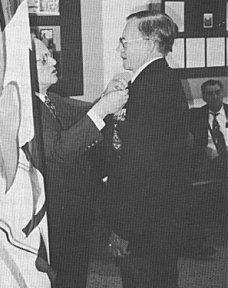
Eric Cameron receiving the Malta George Cross
from the Maltese Consul-General July 31, 1993.
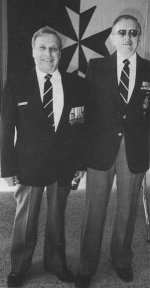 |
Al Glazer and Eric Cameron. Al Glazer trained as a Radar
Technical Officer and went to Malta in Jan. 1941 in a Sunderland with two
technicians and primitive ASV Radar equipment. Mission, to equip 69 Squadron’s
three Wellingtons with radar to help them in their night shipping strikes.
Glazer learned navigation and earned one of the few RO half wings. He was
awarded the DFC and Mentioned in Dispatches during two Op. tours. In addition
to the Malta George Cross, Al was awarded the Canada 125th Anniversary
Medal.
Al Glazer developed special radar liaison between the Wellingtons and the Malta based submarines, whereby a Morse key hook up to the radar enabled the aircraft to send coded “blip” messages to submarines equipped with the Glazier-designed receiving aerials attached to their periscopes. After receiving the enemy convoy’s course and speed from the Wellingtons, the submarines could intercept and strike. |
Doug. J. Hicks
Prologue to the following story…
My nephew, who lives in Orillia. owns a couple of aeroplanes… so I was invited to fly with him on a float plane to Oshkosh last summer.
One of the seminars presented at Oshkosh was by an Englishman who is writing a book about the bombing of Dresden. I attended this seminar which included over a 100 people. When the talk was done, a member of the audience stated he was on the ground at the time and witnessed over 50,000 dead. he also stated that the U.S.Airforce came the next day and strafed the survivors. He was quite put out to say the least and with his German accent I thought better of telling him I was there.
Television is now an important part of our daily life. Programming is all encompassing and there is always some form of programming that satisfies our needs. Today, a new channel, called the ‘History channel’ provides us with interesting insights to past events. As a part of the history channel a series called, World War 2 military blunders is currently showing.
A recent episode dealt with the bombing of the German city, Dresden. This was considered by the producers of this series to be a classic blunder. The episode was very controversial . There are two schools of thought on the bombing of Dresden. A major portion of this program dealt with the pros and cons. It seemed to me that the side in opposition of this bombing raid were more ably represented, if I was scoring I think their argument against the bombing was more persuasive. Interviews were conducted, with the two sides to this story ably represented .
In the late stages of World War 2, The city of Dresden was attacked with great force by Bomber Command of the R.A.F. There were some 796 Lancaster, four engine heavy bombers on the initial raid. They attacked in two waves with 244 Lancasters in the first wave This attack was followed up the next two days by the 8th U.S. Air Force Because of the intense bombing of this city ,a firestorm developed and estimates range from 60.000 to over a 100,000 inhabitants being killed. Due to the fact that this city had not been bombed it became a haven for many refugees fleeing the advancing Russian Army.
Up to this point in the war, Dresden had been spared from any bombing raids. Dresden was an old, quaint city , to this point had never been considered a military target. Again as the war wound down another look was taken at the Bomber Command priorities. There was considerable pressure from our Allies, the Russians to show some form of solidarity and to help the Russian effort to invade the German Empire. As the show progressed, both sides used very persuasive arguments as to the the military importance of this bombing raid on Dresden.
The program was very descriptive of the events and when it concluded, I personally sided with that faction that advocated the bombing of Dresden. At the time there was no evident reasons in my mind why I came to this conclusion. For the next few weeks I found myself reliving the program. I would consciously review in my mind the arguments that had been presented during this program, why, I could not fathom. Something was tugging at my inner self and forcing my memory to work overtime. Then I remembered.
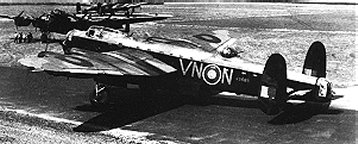
Lancaster. This picture shows Doug’s “Office” in the
tail – lonely spot.
February 13 1945
R.A.F. 550 Squadron, North Killinghome, England. Flying four engine Lancaster Bombers.
Flying Officer Harris and his crew are preparing for their first raid into enemy territory. The crew consists of seven, Five of the crew are Canadians and the other two English. Flying Officer Harris had made his “Second Dickie” flight to Germany on February 8th, the target was the Politz oil plant. The rest of the crew are all virgins. I, Flt. Sgt. Hicks, flew with this crew as the Tail Gunner. All of our training flights had been completed without incident. As a crew we were now competent to take on the duties of an active flight crew. This is our first operational flight.
Briefing was completed and we were assigned aircraft BQ-V. This aircraft was named the “Vulture Strikes” by the first crew to whom it was assigned permanently. Our confidence is bolstered by the fact that this aircraft had completed in excess of 90 trips over enemy territory. It had always returned the crew back home safely. Now, we would see, how we as a crew, would function under actual combat.
After take off we set course for the assigned target. There was very little banter between the crew and only essential information was relayed. By listening in, one would wonder if this crew was working correctly. I had expected some banter between crew members to relieve the tension but the atmosphere was one of doing the job. From my position at the rear of the aircraft, the old saying, I don’t know where we are going but I certainly know where we have been, came true. We are now some 4 hours into the flight , all has been uneventful, Then some 50 miles from the target a huge red glow can be seen in the sky ahead. We have no doubt where we are to go. Our behaviour changes, this is it, this will be our trial by fire. We approach the target and the Bomb Aimer takes over directing the aircraft on the correct heading for the bombing run. Conditions change and almost daylight conditions prevail. The sky is lit up from the horrendous inferno on the ground that is now the target. In this lighted environment I now see Bomber aircraft everywhere. They are to the left and the right, up and down, it seems almost impossible that this zone of air space can accommodate so many bomber aircraft. As one of the bombers passes underneath my turret I can see the crew in the cockpit of the aircraft and notice the red hot exhaust from the four engines glowing eerily in the sky. I have difficulty in comprehending this vast armada of aircraft converging on the target. As quickly as it started we have now dropped the bomb load and turned to head for home. So this is the trial under fire, we did it we have almost completed our first trip. There is no jubilation from the crew nor even a slight hurrah, it seems we are all busy doing our jobs and the jubilation will wait till we get home.
We return home safely with no incidents to report. “V” for victor has done it again our trust in this old war horse has been justified. We land at our home base without incident. This trip lasted for ten hours and five minutes. We have lost our virginity and still there is no jubilation. It seems we did what we were trained to do and that triumphant cries of jubilation will wait for another time. At debriefing we tell of the horrendous fires that were evident over the target and we wonder aloud if anyone on the ground survived that holocaust. The papers will report on this raid in the morning with glowing accolades to those crews who participated.
My first trip is over. The target that night, DRESDEN.
VOLUNTEERS
One thing we had in common, we were all volunteers. So why was it that the older types always warned us – DON’T VOLUNTEER FOR ANYTHING.
There are the stories about the Sgt asking if there were any truck drivers in the ranks, and when a few chaps put up their hands they found themselves on the business end of a wheelbarrow moving bricks from point A to point B. At Calgary it was, “can anyone spin a prop?” I was caught on that one as I thought I would be working on the flight-line starting Tiger Moths. I ended up with a push broom sweeping the apron at Sheperd Field. Just when I got finished an aircraft swung around in front of the hangar and the pilot revved the engine before shutting down. All my hard work blew back into my face!
However, one volunteer episode did pay off. It was during the Calgary Stampede 1941. Our entry was ordered to march in the big Calgary Stampede parade. It was a terribly hot day and we were still in our heavy blues. We didn’t march in columns of three as we had practiced on the parade square, they lined us up eight abreast with a band in front and one behind both playing a different beat. We must have looked like a herd of cattle wandering down the street.
At the end of the parade we were dismissed. A civilian came up to some of us and said, “I need eight volunteers.” There was a lot of grumbling, “stick it mate,” or “shove off.” All most of us wanted was to wrap ourselves around a cool beer. For some reason, maybe it was because the civilian chap said that he was a reporter for the Calgary Herald, Gordon Frost and I said we would volunteer.
The assignment? We couldn’t believe it. There were eight Drum Majorettes from Great Falls, Montana, in the parade and the City of Calgary was hosting a banquet for the visitors that evening at the Palliser hotel. They required eight young lads to sit with the girls during the dinner. When word got around it was not hard to get six more “volunteers”.
We went back to barracks and shined up for the occasion. At the appointed time a car picked us up and drove us to the hotel. We were introduced to the girls who ranged in age from 17 to 18 and were seated girl boy, girl boy, at the banquet table. As the Americans were not yet involved in the war, the girls made a great fuss over their uniformed escorts.
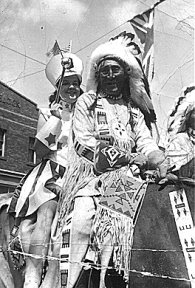
Dorothy Reilly (mounted behind), Great Falls Montana,
in the Calgary parade June 1941
We never saw the girls again but some of us corresponded for a short time. After Pearl Harbour they had a lot of home grown boys in uniform to admire.
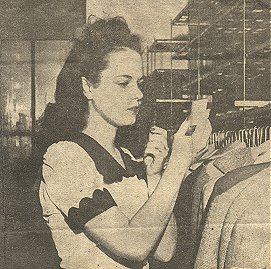
Dorothy - Last letter–
clipping from Great Falls Tribune, Sunday, July 5,
1942.
These young ladies made eight lonely boys feel important. They will be in their seventies now, it is hoped that life has been kind to them.
Gordon Frost was killed in action, age 21, flying out of Cylon. Gordon rests in a military cemetery in New Delhi, India.
If any readers have interesting “volunteer” stories, send them in.
CORRESPONDENCE
A few comments on Wimp's memories of the Oak Tree pub (I seem to remember it as the Pine Tree but then 60 years have passed.) at the gate to Middleton St. George base and his memories of the "kiss of death" . The two girls he mentioned were pretty well a nightly fixture at the pub and the blonde was well known to have the label "kiss of death' for the reason Wimp mentioned. Our crew frequented the pub on a regular basis and I recall were well warned of the blondes reputation. Nevertheless our navigator seemed to find her attractive but out of respect for the rest of the crew that was as far as it went - that is until our tour was completed. On our return to the pub after our last trip all inhibitions were cast aside and he soon was enjoying her company. I've forgotten some of the details but recall him returning to the barracks later in the night in foul humour and soaking wet. Apparently his amorous intentions hadn't come up to his expectations and his only reward was a long walk in the rain.
Some years later (think it was around 1960) I revisited the pub and in conversation with the publican he asked me if I remembered the two girls one of whom we called the "kiss of death" . Assuring him that I did he commented that they still frequented the pub and might be in that night. I didn't stick around to find out.
Another memory of the pub was of the fine couple who ran the pub . The matron was a friend of everyone and had almost a mother-son relationship with some of the boys. We reciprocated by calling her "mom" . I think "mom" shed quite a few tears when crews were lost. Again on my revisit to the pub mentioned above the publican informed me that "mom" had passed away some years earlier. Expressing my regrets I made the comment that she probably would not have remembered me .He immediately replied that she certainly would have since she remembered all the boys who had revisited in later years.
Bob Marshall (ex 428 squadron)
Guelph ,Ont.
rgmar @sympatico.ca
BRANCH REPORTS
Smokey Robson reported that there were 19 in attendance at their May luncheon.
(Ed. I’m sure Members would appreciate hearing from other Branches across our fair land. Have a Member drop your Editor a short report on your Branch’s activities.)
Editors Report
Readers will note that ASV Radar has been mentioned a number of times in different articles. Wellingtons directing Submarines at Malta onto the target is very similar to Ross’s account of Wellingtons directing fighters onto the V-1 carrying Heinkels. Could this be AWACS 1941?
To carry this a step further, what about the stationary,
manned, balloons behind the trenches in WW1, whereby the airborne observers
zeroed ground forces in on the enemy.
AWACS (Airborne Warning and Control Systems) is certainly
an all-inclusive term.
Now I will sit back and wait for the flak.
As we have mentioned before, the Air Gunner branches receive this Web Page at no cost thanks to the CATP Museum in Brandon, MB, and our Volunteer Web Master Bill Hillman. At your luncheons please don’t forget our Sponsors, an honorarium to both would be appreciated. The addresses are in this page.
Send in your WWII stories, lets keep our SHORT BURSTS page alive.
At the top of this page you should see two web pages mentioned. Click on RAF Friends. This looks interesting.
We will be back July 1/03. Keep well. And to my Maritime and Newfoundland friends,
Long may your big jib draw
Cheers, John and Doreene Moyles
